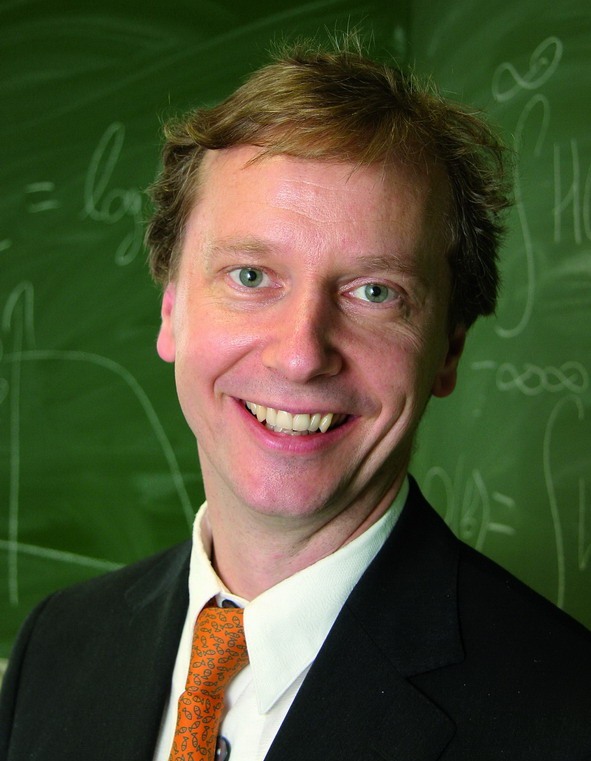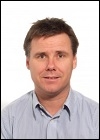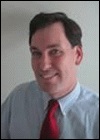IEEE ICC 2013 Keynote Speakers
Monday, June 10, 9.00 - 9-45
Gerhard P. Fettweis, TU Dresden: 5G - What will it Be: The Tactile Internet
Tuesday, June 11, 11.00 - 12.30
Erik Dahlman, Ericsson: Wireless Access for the Future Networked Society
Walter Goldenits, Magyar Telekom, Transformation from a traditional telco provider to a multiservice community enabler
Wednesday, June 12, 11.00 - 12.30
Thomas Wiegand, Fraunhofer HHI, TU Berlin: Advances in High Definition and 3D Video Coding
Peter Winzer, Bell Labs, Alcatel-Lucent: Optical Transport Is Going MIMO
 |
Gerhard P. Fettweis
cfAED Scientific Director and Coordinator
Vodafone Chair Professor
TU Dresden |
5G - What will it Be: The Tactile Internet
Mainstream wireless communications has enabled applications and services as cordless & cellular telephony, wireless data access, multimedia content delivery, and is now moving towards machine-type-communications (MTC/M2M). Within this context, cellular communications has been advancing at a steady pace, with the introduction of a new digital cellular standard every 10 years. Starting with the introduction of 2G, then 3G, and now 4G, every standard required major innovations and has been a great step forward in technology. When making projections, 5G cellular will be deployed approximately a decade from now. Hence, now is the time to decide on new key application & service enabling ingredients, as well as technology enablers.
The TACTILE INTERNET will be proposed within this talk, leapfrogging future application enablement. It will have a dramatic impact into our daily life, advancing the planet to a better and safer place. The extreme requirements on latency and resilience are analyzed. A proposal for a new physical air interface are addressed by the use of GFDM (Generalized Frequency Division Multiplexing), showing that the feasibility of the vision of the TACTILE INTERNET.
Slides: PDF
Biography: Gerhard Fettweis earned his Ph.D. under H. Meyr's supervision from RWTH Aachen in 1990. Thereafter he was one year at IBM Research in San Jose, CA and then at TCSI Inc., Berkeley, CA. Since 1994, he is Vodafone Chair Professor at TU Dresden, Germany, with currently 20 companies from Asia/Europe/US sponsoring his research on wireless transmission and chip design. Gerhard is IEEE Fellow, member of acatech, has received an honorary doctorate and multiple awards. In Dresden he has spun-out nine start-ups so far, and setup funded projects of more than EUR 1/4 billion volume. He has been actively involved in organizing IEEE conferences, most notably being TPC Chair of IEEE ICC 2009, TTM 2012, and General Chair of VTC Spring 2013. He remains active within IEEE societies as well as their publications.
Back to top
 |
Erik Dahlman
Senior Expert in Radio Access Technologies
Ericsson Research |
Title: Wireless Access for the Future Networked Society
The vision for the future networked society is a world with unlimited access to information and sharing of data available anywhere and anytime for anyone and anything”. To approach this vision, new technology solutions are needed in all area of communication, not the least within the wireless access. This presentation will outline the vision of the networked society and the challenges it will create and discuss steps that may be taken to address these challenges.
Slides. PDF
Biography: Erik Dahlman received the Master of Science degree and Doctor of Technology degree from the Royal Institute of Technology, Stockholm in 1987 and 1992 respectively. He is currently the Senior Expert in Radio Access Technologies within Ericsson Research. Erik Dahlman was deeply involved in the development and standardization of 3G radio access technologies (WCDMA and HSPA), first in Japan and later within the global 3GPP standardization body. More recently he has been involved in the standardization/development of the 3GPP Long Term Evolution (LTE) and its continued evolution. He is currently part of the Ericsson Research management team working with long-term strategies in the area of radio-access technologies. Erik Dahlman is the co-author of the book 3G Evolution – HSPA and LTE for Mobile Broadband and its follow-up 4G – LTE and LTE-Advanced for mobile broadband. He has also participated in three other books within the area of radio communication, as well as numerous journal papers and conference contributions. In 1998 he received the IEEE Jack Neubauer Best System Paper award for the paper WCDMA – The Radio Interface for Future Mobile Multimedia. Erik Dahlman holds more than 80 patents in the area of mobile-radio communication and has been named the Inventor of The Year within Ericsson. In October 2009, Erik Dahlman received the Major Technical Award, an award handed out by the Swedish Government, for his contributions to the technical and commercial success of the HSPA radio-access technology.
Back to top
 |
Walter Goldenits
Chief Technology and IT Officer
Magyar Telekom |
Title: Transformation from a traditional telco provider to a multiservice community enabler
Facing the challenges of the continuously changing telco market Magyar Telekom, the leading incumbent service provider in Hungary took courageous steps by entering various non-traditional telco market segments like satellite TV broadcasting, retail electricity and gas distribution, media and insurance in the near past. The speech intends to lead through different aspects of this journey by treating external and internal factors such as market and technology evolution, organizational and process changes, IT transformation, people and culture development.
Slides. PDF
Biography: Walter Goldenits (born in 1970) received a technical mathematics degree from Technical University Vienna. He started his career in telecommunications at Mobilkom Austria in 1998 in the IT department, and then from 2003, as Head of IT. After 2007, he has held multiple executive positions in Telekom Austria group, first heading the IT and Network’s division of si.mobil, and then served as Chief Technology Officer in Telekom Austria wireline, where he was responsible for optimisation of the organisation, technology lifecycle management and IT transformation. In 2010, upon the merger of Mobilkom Austria and Telekom Austria into a single entity to form A1 Telekom Austria, he was appointed as Chief Technology Officer, where his principal responsibilities involved the integration of the wireline and wireless technology units, rollout of LTE and fiber technology and IT hamonisation. From January 1, 2013 he has been Chief Technology and IT Officer of Magyar Telekom
.
Back to top
 |
Prof. Dr.-Ing. Thomas Wiegand
Head, Image Processing Department, Fraunhofer HHI
Chair, Image Communication, TU Berlin |
Title: Advances in High Definition and 3D Video Coding
With the increased growth of video traffic, coding and compression of video are as important as ever. The deployment of HD and the arrival of 3D and Ultra HD content on flat screens and portable devices will push the limits even further. Already today, video related Internet and mobile traffic exceeds more than 50% of the overall traffic in each domain. This process is expected to continue with some predictions forecasting video to be the clearly dominant type of traffic.
Today, the majority of the video bits are compressed using the H.264/MPEG-AVC standard, which has been the driving force behind HD video. In recent years, a successor has been standardized: H.265/MPEG-HEVC. The aim of the new standard was to half the bit rates needed by its predecessor. The scope of these video coding standards also covers scalable video coding and support for stereo as well as autostereoscopic 3D video. This keynote will provide an overview of the advances in high definition and 3D video coding.
Biography: Thomas Wiegand is a professor at the department of Electrical Engineering and Computer Science at TU Berlin and is jointly heading the Image Processing department of the Fraunhofer Heinrich Hertz Institute, Berlin, Germany. He received the Dr.-Ing. degree from the University of Erlangen-Nuremberg, Germany, in 2000. He has been a visiting researcher to Kobe University, UC Santa Barbara and a visiting professor to Stanford University. Since 1995, he has been an active participant in standardization for multimedia with successful submissions to ITU-T VCEG, ISO/IEC MPEG, 3GPP, DVB, and IETF. He received a number of awards including the Innovations Award of the Vodafone Foundation, the EURASIP Group Technical Achievement Award, the Eduard Rhein Technology Award, the Karl Heinz Beckurts Award, and the IEEE Masaru Ibuka Technical Field Award. He is a Fellow of the IEEE and has been active within IEEE in many capacities including associate and guest editorships as well as awards committee membership.
Back to top
 |
Peter Winzer
Director
Optical Transmission Systems and Networks Research
Bell Labs, Alcatel-Lucent
USA
|
Title: Optical Transport Is Going MIMO
Over the past decade, fiber-optic communication systems have embraced a wide range of digital communication techniques long established in radio-frequency communications, such as digital coherent detection, adaptive equalization, higher-level modulation, orthogonal frequency division multiplexing, and soft-decision forward error correction. Integrated into chip sets with internal data buses of several Tbit/s, the resulting cutting-edge optical transponder products support per-channel information rates beyond 100 Gbit/s, with aggregate per-fiber capacities of more than 10 Tbit/s using wavelength-division multiplexing (WDM). With this enormous progress, however, per-fiber capacities are rapidly approaching the recently identified Shannon limit of the nonlinear fiber-optic channel. Fundamentally new technologies will be required to enable fiber-optic transport systems to scale to Pbit/s capacities and beyond, as needed to support the unabated exponential network traffic growth. Space-division multiplexing using multiple-input multiple-output techniques (MIMO-SDM) has been identified as the only long-term scalable solution to the problem, and is now being heavily researched within the global fiber-optics communications community, both for network capacity scaling and for the information-theoretically secure transmission of vast amounts of data.
Slides: PDFBiography: Peter J. Winzer received his Ph.D. in electrical engineering from the Vienna University of Technology, Austria, in 1998. Supported by the European Space Agency, he investigated space-borne Doppler lidar and laser communications using high-sensitivity digital modulation and detection. In 2000 he joined Bell Labs, focusing on many hardware, systems, and architectural aspects of fiber-optic networks research and setting several high-speed and high-capacity optical transmission records. He has widely published and patented and is actively involved in technical and organizational tasks with the IEEE Photonics Society and the Optical Society of America (OSA). He was promoted Distinguished Member of Technical Staff at Bell Labs in 2007 and since 2010 heads the Optical Transmission Systems and Networks Research Department. He is a Fellow of the OSA and the IEEE.
Back to top





